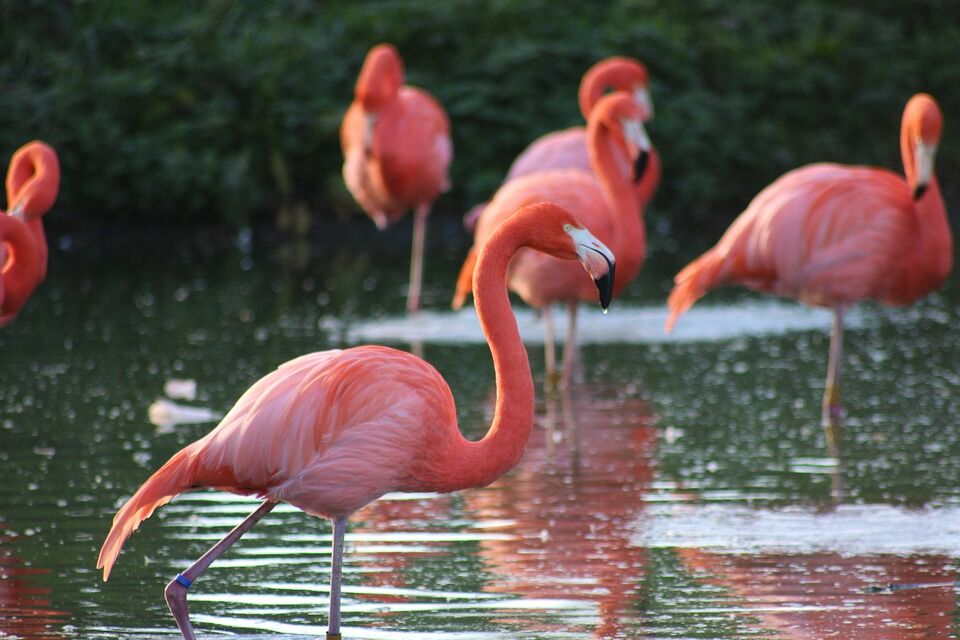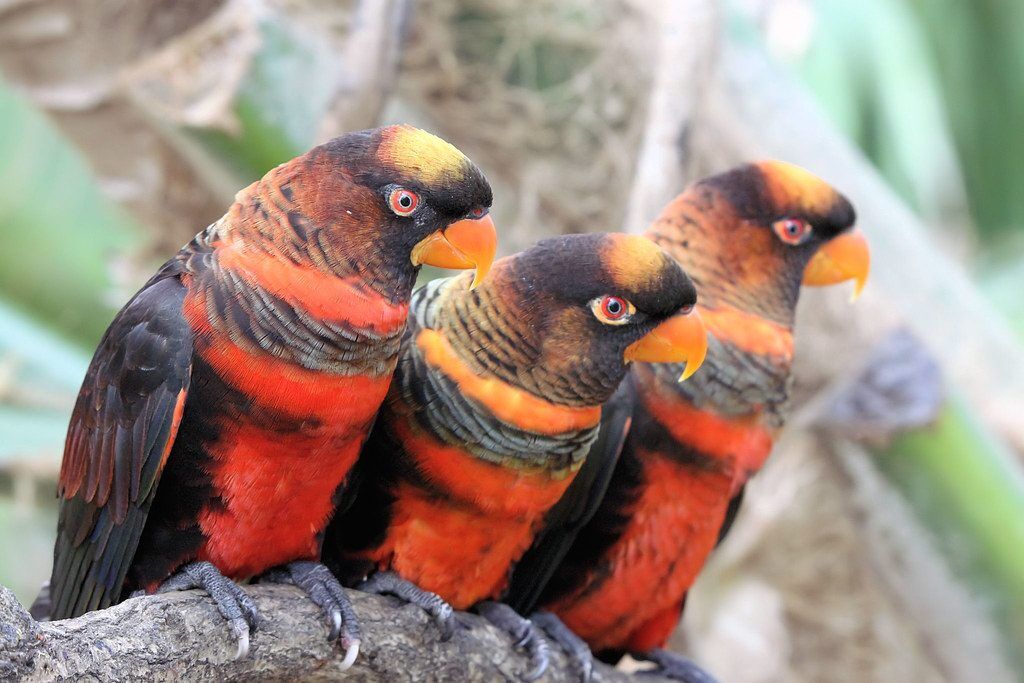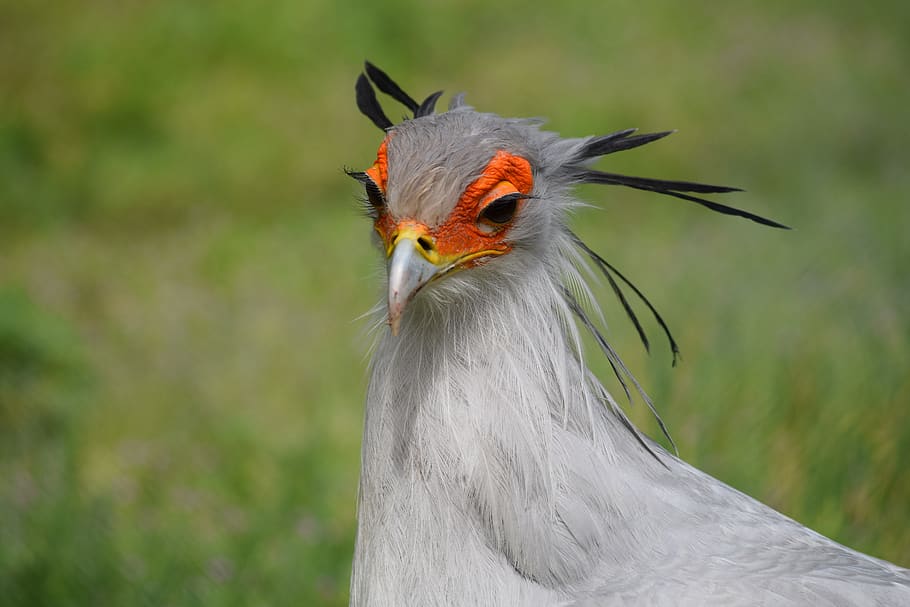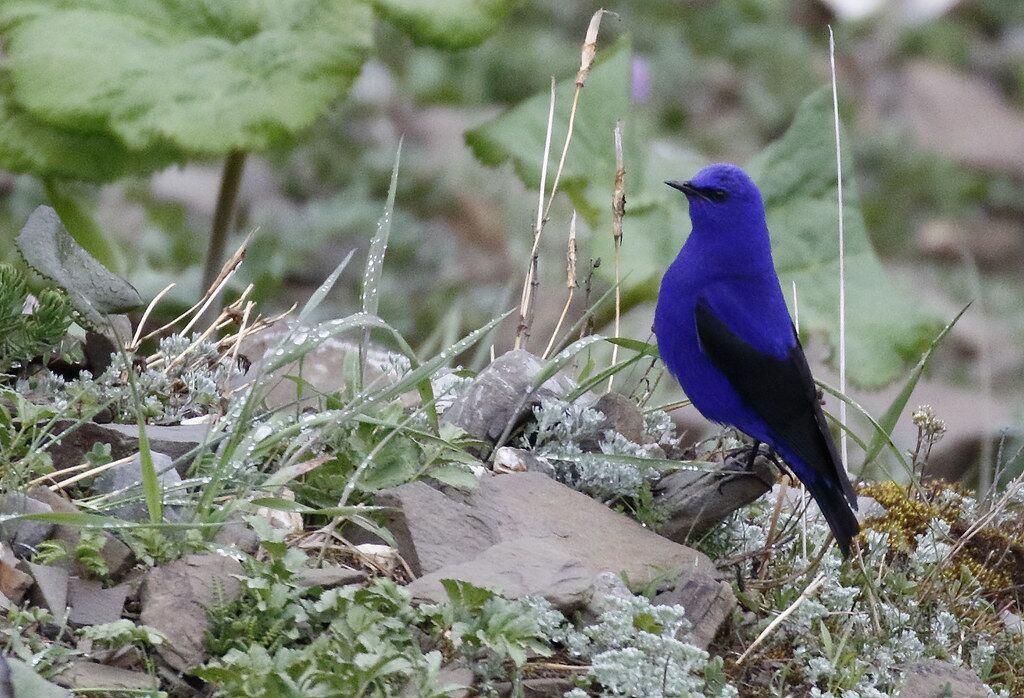Beautiful birds can be seen across the globe, but which ones are the prettiest?
The most beautiful birds in the world come with a mind blowing array of colors, patterns, habits and if that’s what you’re looking for, you’ll love this guide!
Check out our list of the 30 top beautiful birds to discover more…
You’ll learn what makes each of these beautiful birds unique, where they live, what they eat, and what they look like.
Here’s our list of the top 30 prettiest birds in the world
1. Blue Jay

Blue Jays, Latin name Cyanocitta cristata, are native to North America but are commonly found in the central and eastern regions of the United States.
They’re ten inches in length and weigh three ounces. Blue Jays eat nuts, seeds, and acorns, but they are known to eat small insects such as grasshoppers, caterpillars, or beetles.
These beautiful birds are recognizable by their bright blue colors, contrasting light grey chest, and white face.
One unique identifier of the Blue Jay is when they are frightened or upset the crest on their head will stand up.
2. Red Crested Turaco

The Red-crested Turaco, also known by the Latin name Tauraco erythrolophus, is native to Africa. They can be found in the savanna, woodlands, and forests of sub-Saharan Africa.
Red Crested Turacos are about 20 inches in length and weigh less than 1 pound. They eat seeds, fruits, flowers, leaves, and termites.
These birds are not the best flyers, but they can run extremely fast and they sound like a jungle monkey. They are green bodied, white-faced, and have a red crest.
Their beautiful red crest can stand up nearly two inches.
3. Golden Pheasant

Coming in at number 3, this is one of the prettiest birds in the world…
Golden Pheasants, Latin name Chrysolophus pictus, are also called “rainbow pheasant” and “Chinese pheasant”. They are local to the mountains of the west and central China.
Males can measure up to 3 ½ feet and females up to 2 ½ feet. They eat berries, grains, seeds, and grubs.
They are identified by their unique and beautifully golden crest, their feathers that range in a rainbow of colors, and long tail feathers.
4. Painted Bunting

Painted Buntings, Latin name Passerina ciris, are found in the southern parts of North America and migrate south to Central America and the Caribbean.
They eat seeds and grains unless they are breeding, then they will eat a wide variety of insects, too.
The male birds have beautiful, vibrant blue, red, green, and yellow colors that can be seen once the bird has reached the age of two.
5. Flamingo

Flamingos, Latin name Phoenicopterus, are native to the Americas (Caribbean), Africa, Asia, and Europe.
They can stand over 4 feet tall and weigh up to 7 pounds. They eat small insects, shrimp, and blue-green algae.
Flamingos get their beautiful pink color from the shrimp they eat. The more shrimp they eat, the brighter their feathers will be, the less shrimp they eat the whiter they will look.
They are often seen standing or sleeping on one leg, with the other leg tucked up underneath them.
6. Hyacinth Macaw

Hyacinth Macaws, Latin name Anodorhynchus hyacinthinus, are found in eastern and central South America, but many people keep them as pets. They measure about three feet long and weigh around 3 ½ pounds. They eat hard nuts and seeds. Their beaks are strong enough to crack a coconut.
These birds are recognizable by their bright cobalt-blue feathers with yellow accents around their eyes and beak. They are the largest of the parrot species and are known for being gentle and loud.
7. Quetzal

The Quetzal, Latin name Pharomachrus mocinno, are found in forests from Mexico to Panama.
These birds are just over a foot long and weigh just ¼ of a pound. They eat fruit, lizards, insects, and other small creatures.
You’ll recognize a Quetzal by its beautiful red, blue and green colors.
The male Quetzals have unique twin tail feathers that they lose when they mate, while the females do not have long twin tail feathers (nationalgeographic.com).
8. Hoopoe

The Hoopoe, Latin name Upupidae, live in Africa, Europe, and Asia. They grow up to 5 inches in length and weigh just 2 ounces.
These birds eat a variety of bugs including ants, beetles, crickets, locusts, and more.
They are identifiable by their long beak, black and white striped feathers, brown heads, and brown crest with black and white stripes on the tips.
The Hoopoe is the national bird of Israel.
9. Atlantic Puffin

The Atlantic Puffin, Latin name Fratercula arctica, is found near the Atlantic Ocean. They are about a foot in height and weighs about a pound. Atlantic Puffins eat crustaceans and fish.
These birds have a black body, white chest, and vibrant orange feet. Their beak changes colors from bright orange to grey in the winter.
Their coloring is close to penguins, but they look more like a parrot than a penguin.
10. Green Wing Macaw Parrot

The Green Wing Macaw Parrot, Latin name Ara chloropterus, lives in central and northern South America.
They are about 40 inches long and weighs just under 3 pounds.
These birds eat berries, fruit, nuts, and seeds.
Green Wing Macaw Parrots are known for their bright red, blue, and green colors.
Their bodies usually feature vibrant red feathers, with a green band around their wings and back, with blue on the tips of their wings and tail feathers.
11. Stork-billed Kingfisher

The Stork-billed Kingfisher, Latin name Pelargopsis capensis, is found in Southeast Asia and the tropical regions of India. They grow up to 14 inches and ½ a pound.
These birds eat fish, rodents, crabs, frogs, and other small birds.
The Stork-billed Kingfishers are known for their long, red beaks, brown heads, yellow chests, and blue wings.
12. Peafowl

The Peafowl, Latin name Pavo cristatus, is most commonly known as the Peacock (which refers to the males) and is native to India. They eat seeds, flowers, plants, small insects, frogs, and small reptiles.
Peafowls grow up to 4 feet tall and weigh up to 14 pounds. The tail feathers can reach up to 6 feet in length.
Peafowls are typically either green or blue bodied with beautiful tail feathers that spread out behind their bodies.
13. Rainbow Lorikeet

Rainbow Lorikeets, Latin name Trichoglossus moluccanus, are native to Australia.
They grow up to a foot in length and weigh up to 5.5 ounces. They eat nectar, fruit, small insects, and pollen from flowers.
These parrots have a bright orange beak and chest. Their heads are blue and wings are green. Their coloring patterns make them unmistakable.
Both males and females display bright and vibrant colors.
14. Keel-billed Toucan

The Keel-billed Toucan, Latin name Ramphastos sulfuratus, is most commonly found in tropical forests from Mexico to Columbia.
They grow up to 6 inches in length and weigh up to 18 ounces. They eat mostly fruit, but will also eat insects, lizards, eggs, and baby birds.
Toucans are widely recognized as a cereal mascot. They have a large, colorful bill with a black body and a sunshine yellow chest.
15. Northern Oriole

The Northern Oriole, Latin name Icterus galbula, lives in northern Canada and migrate as south as the central and eastern United States. They are about 8 inches long and weigh up to 2 ounces.
These birds eat fruits, flowers, nectar, and insects.
These birds are recognizable by their blackhead, fire-orange chest, as well as white streaks on their wings. They are the mascot for the Baltimore Orioles, a Major League Baseball team.
16. African Crowned Crane

The African Crowned Crane, Latin name Balearica regulorum, is native to Africa. They are 3 ½ feet tall and weigh over 7 pounds.
These birds eat grains, seeds, plants, worms, small fish, and eggs.
These majestic birds have black and white bodies with cream-colored tail feathers and a bristly cream-colored crest.
17. Bohemian Waxwing

The Bohemian Waxwing, Latin name Bombycilla garrulus, are native to North America, Europe, and Asia.
They are about 8 inches in length and weigh under 2 ounces. These birds eat primarily fruit, but will sometimes eat insects.
Bohemian Waxwings are mostly light brown and grey; however, their heads are a beautiful peach color, the tips of their wings are blue, and the tip of their tail looks as if it has been dipped in yellow.
18. Broad-Billed Hummingbird

The Broad-billed Hummingbird, Latin name Cynanthus latirostris, is native to North America. They are just 10 cm long and weigh under 4 mg.
Broad-billed Hummingbirds eat nectar and enjoy sugar water from bird feeders.
These beautiful birds feature a long beak with blue and green bodies. Their wing move extremely fast – up to 78 beats per second.
19. Dusky Lory

The Dusky Lory, Latin name Pseudos fuscata, is found in New Guinea and the surrounding islands. They are about 10 inches long and weigh under 10 ounces. These birds eat fruit, seeds, nectar, and insects.
They are known for their bright orange beaks and vibrant orange and yellow feathers. Their feathers can also be blue, green, and yellow.
20. Scarlet Macaw

The Scarlet Macaw, Latin name Ara macao, are native to Central and South America.
Like other Macaws, they are about 3 feet in length and weigh over 2 pounds. They eat fruits, nuts, and seeds, as well as fruits that are toxic to other animals.
Scarlet Macaws are a beautiful mix of reds, yellows, and blues. Their beak is strong and they are known for their loudness even though they are gentle birds.
21. Peacock

The Peafowl, Latin name Pavo cristatus, is most commonly known as the Peacock (which refers to the males) and is native to India. They eat seeds, flowers, plants, small insects, frogs, and small reptiles.
Peafowls grow up to 4 feet tall and weigh up to 14 pounds. The tail feathers can reach up to 6 feet in length.
Peafowls are typically either green or blue bodied with beautiful tail feathers that spread out behind their bodies.
22. Wood Duck

The Wood Duck, Latin name Aix sponsa, is native to North America. These ducks grow up to 21 inches tall and weigh up to 2 pounds. They eat fruits, nuts, and seeds, but their main source of nutrition is from plants.
These ducks are light bellied, marron chested, black-winged, with white accents and a blue-green crest. The males coloring is bolder than the females coloring.
23. Blue Bird-of-Paradise

The Blue Bird-of-Paradise, Latin name Paradisaea rudolphi, are native to Papua New Guinea.
They are under a foot in length and weigh less than ¼ of a pound.
These birds eat mostly berries, fruits, and insects, but have been known to eat reptiles, too.
Blue Birds of Paradise are recognized by their black and blue feathers as well as their black face and blue creased head.
24. Gurney’s Pitta

The Gurney’s Pitta, Latin name Hydrornis gurneyi, is found in the Maylay Peninsula. They are 7 inches in length when full grown and can weight up to ¼ of a pound. These birds primarily eat worms, insects, and slugs.
The Gurney’s Pitta has vivid yellow and orange on its head, along with blue, white and brown bodies.
Females are not as bright as the males, but still have the blue cap on top of their heads.
25. Lilac Breasted Roller

The Lilac Breasted Roller, Latin name Coracias caudatus, is native to Africa. They are under 4 inches in length and under 4 ounces, too. These birds eat insects as well as small amphibians and lizards.
These beautiful birds are green and blue in color and feature a lilac chest. They have brown eyes and a black bill.
26. The Secretary

Found in the open grasslands and savanna of the sub-Saharan region, the Secretary bird is a large and primarily terrestrial bird of prey. In fact, they are the only living bird of prey with terrestrial habits.
Among all the distinct features, these birds have long legs and slender bodies. The legs will usually have thick scales, which protect them from snakebites. A grown secretary bird is usually around 47 inches long and has a wingspread of about 83 inches.
Another unique thing about these birds is that they will have black crest features. Those make them seem like they are carrying quill pens behind their ears, which is exactly where they get their name from. How so? In the early days, secretaries would generally have pens behind their ears.
Furthermore, these birds usually have a light grey body, black flight features and thighs, and white wing linings. The head and the beak resemble those of the caracara. Also, the tail of these birdies has a pair of long central streamers.
27. Blue Crowned Pigeon

Otherwise known as the Victoria Crowned Pigeon, the Blue Crowned Pigeons are large and have a blue-grey body with lacy blue crests over the head. They will also have dark blue mask features around the eyes.
The habitat of these birds is in the lowland forests of New Guinea. Usually, they will make solid and compact nests that will be of dead stems, leaves, and sticks. These birds are low to the ground and will remain 12 to 50 feet above ground level.
That said, the female blue crowned pigeons will usually lay one elliptical egg. Both the male and female will take part in incubating the eggs. Although they are terrestrial, they do tend to spend nights on treetops. And they are pretty friendly and can not fly as fast as some other birds, making them easy prey.
28. Long Tailed Tit

This bird lives up to its name. You can easily recognize one of them by looking at their tail. As you might have guessed, the tail will be longer than their bodies. Talking of which, the bodies of these birds are generally white, pink, and black.
These birds will generally remain in the parks, woodland, hedgerows, and gardens. And they will mostly build nests that will be out of moss. To camouflage their home, they will utilize lichen and cobwebs. And to make their home soft, they will line as many as 1500 feathers.
Nonetheless, the long-tailed tits will generally lay eight to twelve eggs. And they are very active feeders. They hunt out spiders, insects, and other small insects found on the leaves and smaller branches of trees. These birds are also well-adapted to towns and will visit the feeders and bird tables that are found in the gardens.
29. Mountain Bluebird

You will spot the Mountain Bluebirds between perches in mountain meadows, cut-over or burned areas, or places where the prairie meets the forest. The male Mountain Bluebirds will usually be in the open habitats. And you can find them around the regions of western North America.
So, what are the distinct features of these cavity-nesters? Well, they will be small in size. They have black eyes and a light underbelly. The adult males are bright turquoise-blue in color and have thin bills.
On the other hand, adult females have relatively duller blue wings and tails. They also have grey crowns, breasts, throat, and back.
However, in the fresh fall plumage, the throat and breast of the female birds will have a red-orange tinge, and the flank will be brownish. Nonetheless, these birds are omnivores and can live for anywhere between six to ten years in the wild.
The main eating habit of the birds are grasshoppers, spiders, flies, other insects, and small-sized fruits.
30. Grandala

The Grandala tends to fly with a huge flock. Usually, the flock will have 400 to 500 birds. And they will mostly be across the northeastern Indian Subcontinent and some of the adjoining regions. These birds feed on insects and berries.
That said, the males will have a blue-gray plumage on their bodies. And their wings and tail are black in color. On the other hand, the females will have white and brownish stripes on their bodies. Some even ahs rum gray-blue color profile. But the underside and the tip of the wing feathers are white for the females.
However, the young Grandalas will have a plumage that is pretty similar to the females. You can easily recognize these birds b the sound that they make. They will usually make “dewee” or “dew-ee” sound. Check more info here.

